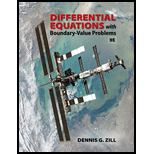
The steady-state temperature in a hemisphere of radius r = c is determined from
0 < r < c, 0 < θ < π/2
u(r, π/2) = 0, 0 < r < c
u(r, θ) = f(θ), 0 < θ < π/2
Solve for u(r, θ). [Hint: Pn(0) = 0 only if n is odd. Also see Problem 20 in Exercises 11.5.]
Trending nowThis is a popular solution!

Chapter 13 Solutions
Differential Equations with Boundary-Value Problems (MindTap Course List)
- Please refer belowarrow_forwardHi, can you guys help me with this? Thank you! Can you guys help me calculate again the Term GPA, Combined GPA, Cumulative GPA, Transfer GPA & Combined Cumulative GPA section? It's just not right right now. Here's the transfer totals point that I want to provide just in case you guys may ask where I get these from:arrow_forwardUse undetermined coefficients to find the particular solution to y"-3y+2y=4e3 Y(t) =arrow_forward
- Please refer belowarrow_forwardUse undetermined coefficients to find the particular solution to y"-y+5y = 7t² +61 +3 Yp(t) =arrow_forwardConsider the initial value problem y"+y'-12y= 0, y(0) = a, y'(0) = 4 Find the value of a so that the solution to the initial value problem approaches zero as too a =arrow_forward
- Consider the initial value problem y"+y'-12y= 0, y(0) = a, y'(0) = 4 Find the value of a so that the solution to the initial value problem approaches zero as too a =arrow_forwardPlease refer belowarrow_forwardThe 173 acellus.com StudentFunctions inter ooks 24-25/08 R Mastery Connect ac ?ClassiD-952638111# Introduction - Surface Area of Composite Figures 3 cm 3 cm 8 cm 8 cm Find the surface area of the composite figure. 2 SA = [?] cm² 7 cm REMEMBER! Exclude areas where complex shapes touch. 7 cm 12 cm 10 cm might ©2003-2025 International Academy of Science. All Rights Reserved. Enterarrow_forward
- Algebra & Trigonometry with Analytic GeometryAlgebraISBN:9781133382119Author:SwokowskiPublisher:Cengage
